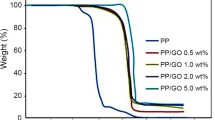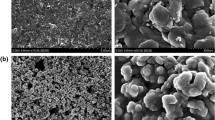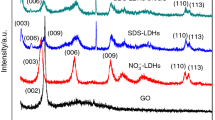Abstract
Layered yttrium hydroxides (LYH)- and graphene oxide (GO)-supported layered yttrium hydroxides (GO–LYH) were synthesized by a co-precipitation route. The additives were characterized by X-ray diffraction and Fourier transform infrared spectra. The LYH were homogeneously dispersed on the GO sheets, demonstrated by the transmission electron microscope analysis. Composites of TPU/LYH and TPU/GO–LYH were prepared by a melt-blending method. The morphologies and structures of the composites, revealed by scanning electron microscope, ascertained that the dispersion of the GO–LYH in the TPU was better because of the strong interaction of the hydrogen bonds between oxygen-containing groups and hydroxyl groups. The fire retardancy of the TPU composites was evaluated using limiting oxygen index (LOI), cone calorimetry and thermogravimetric analysis. The TPU/LYH and TPU/GO–LYH composites, filled with 10 mass% LYH, 9 mass% GO, achieved LOI values of 24.4% and 25.3%, while there was a 67.42% and 70.88% decline of PHRR compared with pure TPU. The improved flame retardancy and smoke suppression were attributed to the physical barrier of GO and the catalytic carbonization of LYH indicated by char analysis.



















Similar content being viewed by others
References
Toldyab A, Szolnoki B, Zimonyi E, et al. Flame retardancy of thermoplastics polyurethanes. Polym Degrad Stab. 2012;97(12):2524–30.
Reddy KR, Lee KP, Gopalan AI. Novel electrically conductive and ferromagnetic composites of poly(aniline-co-minonaphthalenesulfonic acid) with iron oxide nanoparticles: synthesis and characterization. J Appl Polym Sci. 2007;106(2):1181–91.
Reddy KR, Lee KP, Lee Y, et al. Facile synthesis of conducting polymer–metal hybrid nanocomposite by in situ chemical oxidative polymerization with negatively charged metal nanoparticles. Mater Lett. 2008;62(12–13):1815–8.
Najafi M, Ansari R, Darvizeh A. Effect of cryogenic aging on nanophased fiber metal laminates and glass/epoxy composites. Polym Compos. 2019;40(6):2523–33.
Reddy KR, Lee KP, Gopalan AI. Self-assembly directed synthesis of poly(ortho-toluidine)-metal(gold and palladium) composite nanospheres. J Nanosci Nanotechnol. 2007;7(9):3117–25.
Jiao C, Zhao X, Song W, et al. Synergistic flame retardant and smoke suppression effects of ferrous powder with ammonium polyphosphate in thermoplastic polyurethane composites. J Therm Anal Calorim. 2015;120(2):1173–81.
Herrera M, Matuschek G, Kettrup A. Thermal degradation of thermoplastic polyurethane elastomers (TPU) based on MDI. Polym Degrad Stab. 2002;78(2):323–31.
Naik AD, Gaëlle F, Samyn F, et al. Outlining the mechanism of flame retardancy in polyamide 66 blended with melamine-poly(zinc phosphate). Fire Saf J. 2014;70:46–60.
Devedjiev I, Borissov G, Ganev V. Interaction between hypophosphorous acid salts and isocyanates and possibilities of using them as flame retardants for rigid polyurethane foams. Eur Polym J. 1985;21(2):155–7.
Chen X, Jiao C, Zhang J. Microencapsulation of ammonium polyphosphate with hydroxyl silicone oil and its flame retardance in thermoplastic polyurethane. J Therm Anal Calorim. 2011;104(3):1037–43.
Novoselov KS. Electric field effect in atomically thin carbon films. Science. 2004;306(5696):666–9.
Lonkar SP, Deshmukh YS, Abdala AA. Recent advances in chemical modifications of graphene. Nano Res. 2015;8(4):1039–74.
Son DR, Raghu AV, Reddy KR, et al. Compatibility of thermally reduced graphene with polyesters. J Macromol Sci Part B. 2016;55(11):1099–110.
Hassan M, Reddy KR, Haque E, et al. Hierarchical assembly of graphene/polyaniline nanostructures to synthesize free-standing supercapacitor electrode. Compos Sci Technol. 2014;98:1–8.
Seol JH, Jo I, Moore AL, et al. Two-dimensional phonon transport in supported graphene. Science. 2010;328(5975):213–6.
Geim AK, Novoselov KS. Detection of individual gas molecules adsorbed on graphene. Nat Mater. 2007;6:183–91.
Shi Y, Li LJ. Chemically modified graphene: flame retardant or fuel for combustion? J Mater Chem. 2011;21:3277.
Han Y, Wu Y, Shen M, et al. Preparation and properties of polystyrene nanocomposites with graphite oxide and graphene as flame retardants. J Mater Sci. 2013;48(12):4214–22.
Liang J, Huang Y, Zhang L, et al. Molecular-level dispersion of graphene into poly(vinyl alcohol) and effective reinforcement of their nanocomposites. Adv Func Mater. 2009;19(14):2297–302.
Sang B, Li ZW, Li XH, et al. Graphene-based flame retardants: a review. J Mater Sci. 2016;51(18):8271–95.
Han SJ, Lee HI, Jeong HM, et al. Graphene modified lipophilically by stearic acid and its composite with low density polyethylene. J Macromol Sci Part B. 2014;53(7):1193–204.
Lee YR, Kim SC, Lee HI, et al. Graphite oxides as effective fire retardants of epoxy resin. Macromol Res. 2011;19(1):66–71.
Gavgani JN, Adelnia H, Gudarzi MM. Intumescent flame retardant polyurethane/reduced graphene oxide composites with improved mechanical, thermal, and barrier properties. J Mater Sci. 2014;49(1):243–54.
Han Z, Wang Y, Dong W, et al. Enhanced fire retardancy of polyethylene/alumina trihydrate composites by graphene nanoplatelets. Mater Lett. 2014;128:275–8.
Huang G, Liang H, Wang Y, et al. Combination effect of melamine polyphosphate and graphene on flame retardant properties of poly(vinyl alcohol). Mater Chem Phys. 2012;132(2–3):520–8.
Pan Y, Hong N, Zhan J, et al. Effect of graphene on the fire and mechanical performances of glass fiber-reinforced polyamide 6 composites containing aluminum hypophosphite. J Macromol Sci Part D Rev Polym Process. 2014;53(14):1467–75.
Cao Y, Feng J, Wu P. Polypropylene-grafted graphene oxide sheets as multifunctional compatibilizers for polyolefin-based polymer blends. J Mater Chem. 2012;22(30):14997.
Hu H, Wang X, Wang J, et al. Preparation and properties of graphene nanosheets–polystyrene nanocomposites via in situ emulsion polymerization. Chem Phys Lett. 2010;484(4–6):247–53.
Hong N, Song L, Hull TR, et al. Facile preparation of graphene supported Co3O4 and NiO for reducing fire hazards of polyamide 6 composites. Mater Chem Phys. 2013;142(2–3):531–8.
Wang X, Xing W, Feng X, et al. The effect of metal oxide decorated graphene hybrids on the improved thermal stability and the reduced smoke toxicity in epoxy resins. Chem Eng J. 2014;250:214–21.
Feng X, Xing W, Song L, et al. TiO2 loaded on graphene nanosheet as reinforcer and its effect on the thermal behaviors of poly(vinyl chloride) composites. Chem Eng J. 2015;260:524–31.
Choi SH, Kim DH, Raghu AV, et al. Properties of graphene/waterborne polyurethane nanocomposites cast from colloidal dispersion mixtures. J Macromol Sci Part B. 2012;51(1):197–207.
Li D, Müller MB, Gilje S, et al. Processable aqueous dispersions of graphene nanosheets. Nat Nanotechnol. 2008;3(2):101–5.
Poonoosamy J, Brandt F, Stekiel M. Zr-containing layered double hydroxides: synthesis, characterization, and evaluation of thermodynamic properties. Appl Clay Sci. 2018;151:54–65.
Kuila T, Acharya H, Srivastava S. Effect of vinyl acetate content on the mechanical and thermal properties of ethylene vinyl acetate/MgAl layered double hydroxide nanocomposites. J Appl Polym Sci. 2008;108:1329–35.
Conterosito E, Gianotti V, Palin L. Facile preparation methods of hydrotalcite layered materials and their structural characterization by combined techniques. Inorg Chim Acta. 2018;470:36–50.
Reddy KR, Karthik KV, Prasad SBB, et al. Enhanced photocatalytic activity of nanostructured titanium dioxide/polyaniline hybrid photocatalysts. Polyhedron. 2016;120:169–74.
Reddy KR, Sin BC, Ryu KS, et al. Conducting polymer functionalized multi-walled carbon nanotubes with noble metal nanoparticles: synthesis, morphological characteristics and electrical properties. Synth Met. 2009;159(7–8):595–603.
Kakarla RR, Han MJ, Lee Y, et al. Synthesis of MWCNTs-core/thiophene polymer-sheath composite nanocables by a cationic surfactant-assisted chemical oxidative polymerization and their structural properties. J Polym Sci Part A Polym Chem. 2010;48(7):1477–84.
Manzi-Nshuti C, Songtipya P, Manias E, et al. Polymer nanocomposites using zinc aluminum and magnesium aluminum oleate layered double hydroxides: effects of LDH divalent metals on dispersion, thermal, mechanical and fire performance in various polymers. Polymer. 2009;50(15):3564–74.
Zhang Q, Shi JL, et al. Template growth of porous graphene microspheres on layered double oxide catalysts and their applications in lithium–sulfur batteries. Carbon. 2015;92:96–105.
Triantafyllidis KS, Peleka EN, Komvokis VG, et al. Iron-modified hydrotalcite-like materials as highly efficient phosphate sorbents. J Colloid Interface Sci. 2010;342(2):427–36.
Kloprogge JT, Wharton D, Hickey L, et al. Infrared and Raman study of interlayer anions CO32−, NO3−, SO42−and ClO4− in Mg/Al-hydrotalcite. Am Miner. 2002;87(5–6):623–9.
Liu Z, Ma R, Osada M, et al. Synthesis, anion exchange, and delamination of Co/Al layered double hydroxide: assembly of the exfoliated nanosheet/polyanion composite films and magneto-optical studies. J Am Chem Soc. 2006;128(14):4872–80.
Mullica DF, Sappenfield EL, Grossie DA. Crystal structure of neodymium and gadolinium dihydroxy-nitrate, Ln(OH)2NO3. J Solid State Chem. 1986;63(2):231–6.
Rojas R, Barriga C, et al. Intercalation of vanadate in Ni, Zn layered hydroxyacetates. J Solid State Chem. 2004;177(10):3392–401.
Zou H, Sun J, Gu XY, Jiang P, Liu XS, Zhang S. Preparation and characterization of flame retardant and low smoke releasing oil-resistant EVA/NBR blends. Chin J Polym Sci. 2015;33(4):554–63.
Liu L, Hu J, Zhuo J, et al. Synergistic flame retardant effects between hollow glass microspheres and magnesium hydroxide in ethylene-vinyl acetate composites. Polym Degrad Stab. 2014;104:87–94.
Lin M, Li B, Li Q, et al. Synergistic effect of metal oxides on the flame retardancy and thermal degradation of novel intumescent flame-retardant thermoplastic polyurethanes. J Appl Polym Sci. 2011;121(4):1951–60.
Acknowledgements
This work was supported by the National Natural Science Foundation of China (No. 51572138), the Key R & D Project of Shandong Province (Nos. 2019GSF109001, 2019CSF109080 and 2017GSF217013), the Shandong Provincial Natural Science Foundation, China (No. ZR2018BB072), the Original Innovation Project of Qingdao City (No. 19-6-2-23-cg), the Foundation of State Key Laboratory of High-efficiency Utilization of Coal and Green Chemical Engineering (Nos. 2018-K09 and 2018-K43), Key Laboratory of Coastal Environmental Processes and Ecological Remediation, YICCAS (No. 2018KFJJ02) and Opening Project of Shandong Ecochemical Engineering Collaborative Innovation Center (No. XTCXQN02).
Author information
Authors and Affiliations
Corresponding authors
Additional information
Publisher's Note
Springer Nature remains neutral with regard to jurisdictional claims in published maps and institutional affiliations.
Rights and permissions
About this article
Cite this article
Qian, Y., Han, H., Li, L. et al. Combustion behavior and thermal stability of TPU composites based on layered yttrium hydroxides and graphene oxide. J Therm Anal Calorim 142, 409–423 (2020). https://doi.org/10.1007/s10973-019-09181-w
Received:
Accepted:
Published:
Issue Date:
DOI: https://doi.org/10.1007/s10973-019-09181-w




